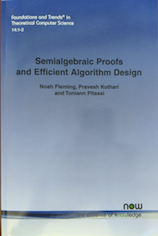
Computer Science Department, Princeton
Associated Faculty
Program in Applied and Computational Mathematics (PACM)
kothari AT cs.princeton.edu
In Spring'24, I am also a Visiting Professor in the School of Math at the IAS.
Upcoming Talks/Events
IndiCS seminar on Continuous methods in discrete optimization and complexity [Oct 24]
Cornell Theory Seminar [Oct 24]
Eastern Great Lakes Workshop, Buffalo [Oct 24]
Cargèse Workshop on Combinatorial Optimization [Sep'24]
Bernoulli Center Workshop on Synergies of Combinatorics and theoretical computer science [Aug'24]
Presburger Award Talk, ICALP, Tallinn, Estonia [July 24]
Workshop on Algorithms for Learning and Economics [June'24]
Plenary Session, Oberwolfach Complexity Meeting [June'24]
Milan Theory Workshop [May'24]
Oberwolfach Meeting on Proof Complexity and Beyond [March'24]
School of Math Colloquium at the Institute for Advanced Study [March 24]
EnCORE Workshop on Computational vs Statistical Gaps in Learning and Optimization [Feb'24]
Banff Workshop on Computational Complexity of Statistical Inference [Feb 24]
Rutgers Theory Seminar[Feb 24]
MIT Statistics and Stochastics Seminar [Feb 24]
MIT-Harvard Reading Group [Feb 24]
Harvard Theory Seminar [Feb 24]
CSDM Seminar at the Institute for Advanced Study [Feb 24]
Research Interests
Algorithms and computational thresholds for average-case computational problems, random matrices, extremal combinatorics
My work is generously supported by an NSF CAREER Award (2021), an Alfred P. Sloan Fellowship (2022), a Google Research Scholar Award (2021), an NSF Medium Grant for collaborative research with Venkat Guruswami (2022), a 2024 seed grant from the Princeton AI Laboratory (joint with Amir Ali Ahmadi) and a 2025 Princeton School of Enginering and Applied Sciences Innovation Grant (joint with Amir Ali Ahmadi).
Research Highlights
Complete list of my papers. Some highlights/resources:
-
The Sum-of-Squares Method and Algorithm Design via Connections to Proof Complexity
- Monograph on Semialgebraic Proofs and Efficient Algorithm Design.
- Fall'21 CMU Lecture notes and videos.
-
Spectral Refutations via Kikuchi Matrices and Applications to Coding Theory and Combinatorics
-
A new class of spectral methods for extremal combinatorics. Applications so far: refuting and solving smoothed SAT (CSPs), settling Feige's conjecture on extremal girth of hypergraphs, and improved lower bounds on locally decodable codes, and an exponential lower bound on three-query linear locally correctable codes.
- A general audience article due to appear in CACM Research Highlights
- Some recent talks.
- Refuting/solving Smoothed SAT and other CSPs(in the sequence [1], [2], [3]).
- Finding planted cliques in Feige-Kilian Semirandom Model (see this book chapter and this paper for history and context on the question).
- Breaking security of certain proposed cryptographic Pseudorandom Generators.
- Some recent talks.
- Resolving the robust learnability of mixtures of high-dimensional Gaussians (in the sequence [1], [2], and [3]) (see 2012 CACM Tech Perspective and Simons Research Vignette for history and context).
- Toolkit for basic estimation: regression, moment estimation, and sparse recovery.
- Efficient estimation in the presence of majority outliers (in the sequence [1], [2], and [3]).
- Overview talk with open questions.
- Lower bounds for SoS SDPs via planted vs null distinguishing problems with applications to random CSPs, planted clique, Tensor/Sparse PCA, with new connections to spectral methods and the low degree polynomial heuristic for computational phase transitions in statistical estimation
- Exponential lower bounds for linear relaxations for constraint satisfaction
- Some talks.
Current Teaching
COS 598I: Matrix Concentration and Applications
Fri, 1:30-4:20pm, COS 104
Office Hours: after class
Service
Workshop Co-Chair, FOCS 2023 and 2024
PC Member APPROX/RANDOM 2018, SODA 2019, STOC 2020, ITCS 2020 , NeurIPS Area Chair 2020,2021, CCC 2022, RANDOM 2022, FSTTCS 2022, FOCS 2023, ITCS 2025, STOC 2025
Advising
Postdocs:
Alperen Ergür (Fall 2019-20, now Assistant Professor of Math and CS at UT San Antonio),
Mitali Bafna (Fall 2022-23, now postdoc at MIT Math)
PhD Students:
Ainesh Bakshi (co-advised with David Woodruff, graduated 2022, Assistant Professor of CS at NYU starting Fall'25, postdoc at MIT Math 2022-25)
Tim Hsieh (postdoc at MIT Math starting Fall'25),
Peter Manohar (winner of the 2023 Cylab Presidential Fellowship, co-advised with Venkat Guruswami, now postdoc at IAS School of Math),
Xinyu Wu (winner of the MSR Ada Lovelace Fellowship, co-advised with Ryan O'Donnell),
Jeff Xu (winner of the 2022 Cylab Presidential Fellowship, postdoc at TTI Chicago starting Fall'25)
Undergraduates:
Shuchen Li (now theory PhD student at Yale University)
Prashanti Anderson ( Alan J Perlis Award for student teaching, runner up to the Alan Newell award for best undergraduate SCS thesis for 2023), now PhD student at MIT EECS,
Misha Ivkov (winner of the Mark Stehlik SCS Alumni Undergraduate Impact Scholarship,now PhD student at Stanford CS),
Zachary Sussman (winner of the Alan Newell Award for best undergraduate SCS Thesis)
Some Representative Papers (for all papers, see here)
Spectral Refutations via Kikuchi Matrices and Applications
- Improved Lower Bounds for All Odd-Query LDCs
With Arpon Basu, Tim Hsieh, and Andrew Lin
FOCS, 2025 (to appear). - Superpolynomial Lower Bounds for Smooth 3-LCCs and
Sharp Bounds for Designs
With Peter Manohar
FOCS, 2024
- Small Even Covers, Locally Decodable Codes and Restricted Subgraphs of Edge-Colored Kikuchi Graphs
With Tim Hsieh, Sidhanth Mohanty, David Munha Correia, and Benny Sudakov
International Mathematical Research Notices (to appear), 2025
- An Exponential Lower Bound on Linear Three-Query Locally Correctable Codes
With Peter Manohar
STOC, 2024 (to appear)
Invited to SICOMP Special Issue for STOC'24 (declined)
- A Near-Cubic Lower Bound for 3-Query Locally Decodable Codes from Semirandom CSP Refutation
With Omar Alrabiah, Venkat Guruswami and Peter Manohar
STOC, 2023.
Invited to SICOMP Special Issue for STOC'23
LONG TALK. - A simple and sharper proof of the hypergraph Moore bound
With Tim Hsieh and Sidhanth Mohanty
SODA, 2023.
LONG TALK. - Algorithms and Certificates for Boolean CSP Refutation: Smoothed is no Harder than Random
With Venkat Guruswami and Peter Manohar
STOC, 2022. LONG TALK.
Invited to the SICOMP Special Issue for STOC 2022, CACM Research Highlights 2023
Algorithms for Learning Mixtures of Gaussians
- Robustly Learning a Mixture of $k$ Arbitrary Gaussians
With Ainesh Bakshi , Ilias Diakonikolas, He Jia, Daniel Kane, Santosh Vempala
STOC, 2022. LONG TALK. - Outlier-Robust Clustering of Non-Spherical Mixtures
With Ainesh Bakshi
FOCS, 2020. LONG TALK.
Conference version to be merged with this paper. - Better Agnostic Clustering Via Relaxed Tensor Norms
With Jacob Steinhardt
STOC, 2018
Conference version merged with this paper.
Algorithms and Thresholds for Semirandom and Smoothed Models
- Rounding Large Independent Sets on Expanders
With Mitali Bafna, Tim Hsieh
STOC, 2025. - Semirandom Planted Clique and the Restricted Isometry Property
With Jaroslaw Blasiok, Rares Buhai, and David Steurer
FOCS 2024 - Efficient Algorithms for Semirandom Planted CSPs at the
Refutation Threshold
With Venkat Guruswami , Tim Hsieh, and Peter Manohar
FOCS, 2023 (to appear). - Algorithms approaching the threshold for semi-random planted clique
With Rares Buhai and David Steurer
STOC, 2023 (to appear).
LONG TALK. - A simple and sharper proof of the hypergraph Moore bound
With Tim Hsieh and Sidhanth Mohanty
SODA, 2023.
LONG TALK. -
Strongly refuting all semi-random Boolean CSPs
With Jackson Abascal and Venkat Guruswami .
SODA, 2021. LONG TALK. -
Sum-of-Squares Lower Bounds for Refuting any CSP
With Ryuhei Mori , Ryan O'Donnell and David Witmer
STOC, 2017.
Algorithmic Robust Statistics and Related Topics
- Efficient Certificates of Anti-Concentration
Beyond Gaussians
With Ainesh Bakshi, Goutham Rajendran, Madhur Tulsiani, and Aravindan Vijayraghavan
FOCS,2024 - Beyond Moments: Robustly Learning Affine Transformations with Asymptotically Optimal Error
With He Jia and Santosh Vempala
FOCS, 2023 (to appear). - Privately Estimating a Gaussian: Efficient, Robust and Optimal
With Daniel Alabi, Pranay Tankala, Prayaag Venkat and Fred Zhang
STOC, 2023 (to appear). - A Moment-Matching Approach to Testable Learning and a New Characterization of Rademacher Complexity
With Aravind Gallakota and Adam Klivans
STOC, 2023 (to appear).
Invited to SICOMP Special Issue for STOC'23 - List-Decodable Covariance Estimation
With Misha Ivkov
STOC, 2022.
- List-Decodable Subspace Recovery: Dimension Independent Error in Polynomial Time
With Ainesh Bakshi
SODA, 2021.
- List-Decodable Linear Regression
With Sushrut Karmalkar and Adam Klivans
NeuIPS Spotlight, 2019. LONG TALK. -
Sparse PCA: algorithms, adversarial perturbations and certificates
With Tommaso D'Orsi, Gleb Novikov, and David Steurer .
FOCS 2020. -
Efficient Algorithms for Outlier-Robust Regression
With Adam Klivans and Raghu Meka
COLT 2018
Prasad Raghavendra's Exposition of our algorithm in a Simons Institute Bootcamp - Outlier-Robust Moment Estimation Via Sum-of-Squares
With David Steurer
STOC 2018 2 hour BOARD TALK.
Conference version merged with this paper.
Algorithms and Complexity of Unique Games and Related Problems
- Playing Unique Games on Certified Small-Set Expanders
With Mitali Bafna , Boaz Barak , Tselil Schramm and David Steurer.
STOC, 2021.
- Quantum Entanglement, Sum-of-Squares and the Log-Rank Conjecture
With Boaz Barak and David Steurer
STOC, 2017
Recent 50 min talk and a shorter talk with a different perspective. - Small-Set Expansion in Shortcode Graph and the 2-to-1 Conjecture
With Boaz Barak and David Steurer
A generally accessible article on the recent proof of the 2-to-2 games conjecture that partly relies on this work.
Average-Case Algorithmic Thresholds
- The Quasi-polynomial low degree conjecture is false
With Rares Buhai, Tim Hsieh, and, Aayush Jain
FOCS, 2025 (to appear) - Sum of Squares Lower Bounds for Independent Set on Ultra-Sparse Random Graphs
With Aaron Potechin and Jeff Xu.
STOC , 2024 (to appear) - Algorithmic Thresholds for Refuting Random Polynomial Systems
With Tim Hsieh.
SODA, 2022. - A Stress-Free Sum-of-Squares Lower Bound for Coloring
With Peter Manohar.
CCC, 2021.
- The power of sum-of-squares for detecting hidden structures
With Samuel B. Hopkins , Aaron Potechin , Prasad Raghavendra , Tselil Schramm and David Steurer
FOCS 2017
Invited to the Highlights of Algorithms (HALG) 2018 -
A Nearly Tight Sum-of-Squares Lower Bound for Planted Clique
With Boaz Barak , Sam Hopkins , Jon Kelner , Ankur Moitra and Aaron Potechin
FOCS 2016. [Video- IAS CS/DM Seminar] [Boaz's WOT post]
Invited to SICOMP Special Issue for FOCS 2016 -
SoS and Planted Clique: Tight Analysis of MPW Moments
at all Degrees and an Optimal Lower Bound at Degree Four
With Samuel B. Hopkins and Aaron Potechin
SODA 2016
Invited to the ACM Transactions on Algorithms, Special Issue for SODA 2016
Conference version merged with this paper. -
Approximating Rectangles by Juntas and a Weakly Exponential Lower Bound for LP Relaxations of CSPs
With Raghu Meka and Prasad Raghavendra
STOC, 2017
Invited to SICOMP Special Issue for STOC 2017
Recent 50 min talk.
Applications
- Sum-of-Squares Meets Nash: Lower Bounds for finding any equilibrium
With Ruta Mehta
STOC 2018 -
Limits on Low-Degree Pseudorandom Generators (Or: Sum-of-Squares Meets Program Obfuscation)
With Boaz Barak , Zvika Brakerski and Ilan Komargodski
EUROCRYPT 2018
Mentoring Talks
I recently gave two mentoring talks as part of the new workshops organized by Learning Theory Alliance
Slides from talk on Interacting with your Research Community.
Slides from talk on Thoughts on PhD Admissions.
